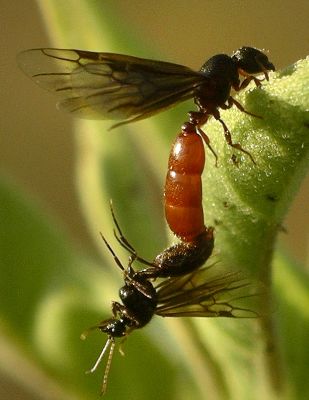
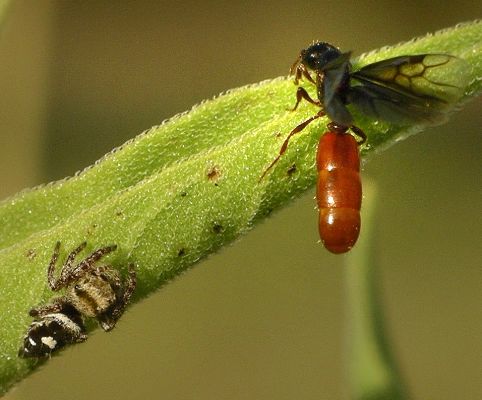
On a recent fauna survey, part of a program called the Fauna Project that I run at the Lady Bird Johnson Wildflower Center in Austin, Texas, we saw just such an encounter. The severe drought that has affected central Texas has forced us to start our surveys as early as possible in order to get in enough observation time before the heat makes it really uncomfortable. Since I am leading the surveys, I start as soon as it is light enough to see and make sure I do not wander too far off before our official starting time of 8:30 AM. Other participants arrive at various times, but at first there are usually only one or two of us beginning to search for signs of life.
This particular morning, two of us decided to check out the dry Wildflower Meadow that is adjacent to the buildings on the property. There is a low ditch that channels water during heavy rains, and several drought-hardy plants living in that area were still remarkably green. This seemed a promising spot to find some insects.
I happened upon a pair of ants mating. This species, Carebara longii, is related to the infamous Imported Fire Ant, but is not nearly as common or annoying. In fact, I've never noticed the workers, but the alates (winged members of the colony that are capable of reproduction) are very distinctive. While the males are all black, the females, which are the future queens of new colonies, have a bright orange-red abdomen.


In the past, I have seen a male, after mating with the queen, climb up onto her back and pull her wings off. Both ants then fell to the ground. This might seem a bit violent, but alates only keep their wings long enough to disperse to new habitat. As soon as the queen has mated, she will manage to rid herself of those cumbersome wings, burrow into the ground, and begin producing the workers of a colony. So the male pulling the wings off might have simply been a way to help her with the next step. I also thought that he might want her to start laying eggs fertilized by HIM instead of the next suitor, so it would be expeditious to make sure she no longer sat up in an obvious place and advertised her presence to other potential mates.
So, upon finding this species mating, I decided to watch to see what would happen next. The male was simply hanging down and not moving. After only a minute or so, he pulled loose and flew off. It was then that I noticed a very small jumping spider approaching. The spider was Phidippus audax, the Bold Jumper. As might be surmised from the name, these arachnids are quite aggressive and will attack prey much larger than themselves. They also might attack a camera lens and even the person holding the camera. It's pretty funny.
While this spider was still immature, it already had the feisty disposition that made it decide to tackle an ant twice its size. Within a minute or so, the spider had stalked close to the ant and then jumped onto it. I thought the spider bit the end of the queen's abdomen, but with a twist, she reached back and seemed to bite the spider. At least she did repel it, whether because of her tough exoskeleton or her large jaws. The spider scurried back down the stem but did not go too far.
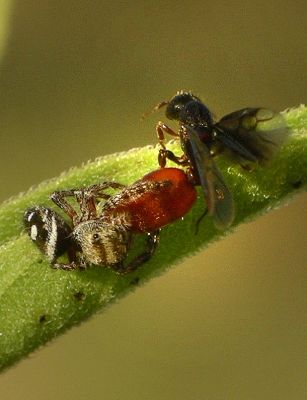
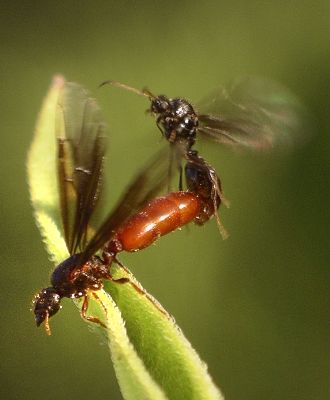
For a short time, the queen simply sat on her perch. Then another male flew up behind her and attached in a mating position. This suitor had a completely different technique from the previous one. Instead of just hanging there, he continued to beat his wings as if trying to fly, causing the female to also flutter as well. But the queen held on with her feet and they never left the leaf on which they were sitting.
The commotion must have been enticing to the little spider, who was watching from a few inches away. It suddenly leapt at the mating pair, grabbed one of the queen's wings and started to tug on it. The male ant seemed quite startled by this development and detached. He remained nearby for a few seconds, as though confused. I imagined that, if this were a Disney cartoon, he would muster all his bravery and drive off the attacker. But this was real life, and things don't work that way. The male simply flew away.
The female continued to struggle with the spider for another 30 seconds, then managed to turn towards it and, once again, appeared to bite it with her large jaws. The spider jerked away and scampered off, this time all the way off the plant.
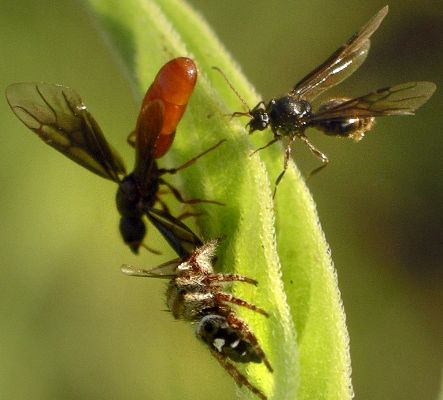
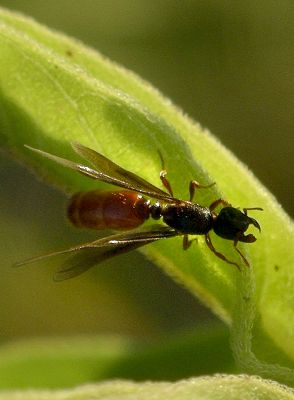
In the end, the queen was left alone on her perch. I needed to move on to other subjects and so left at that point. The entire incident had lasted less than 10 minutes, but I couldn't help but admire the spunk of that little queen. If any ant deserves to establish a new colony, that spirited individual had certainly earned the right.